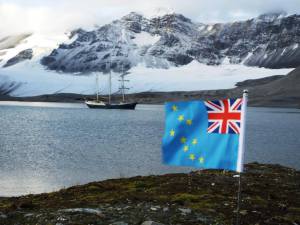Tuvalu National Pavilion at the 56th International Art Exhibition, La Biennale de Venezia
Venue: Artiglierie Building of the Arsenale, Venice
Curator: Thomas J. Berghuis
Artist: Vincent J.F. Huang
Art raises awareness of sea level rise in small island nations
From 1-12 December 2014 nearly 200 countries gathered in Lima, Peru for the United Nations Framework Convention on Climate Change (UNFCCC COP 20). With great anticipation issues of climate change were discussed in various contexts between the global delegates and UN leaders. Ultimately, a new international treaty aims to surpass its predecessor, the Kyoto Protocol, and is drafted for December 2015 in Paris to ratify new reduction standards for global carbon emission. Although such a treaty should be brought into action by the year 2020, the differences of opinion and slow political negotiation between world powers do not salvage the fate of small islands – not to mention the 5-year window period between the treaty’s anticipated ratification and its implementation.
Under the devastating effects of extreme weather, and global nations in a perpetual dilemma of pursuing economic gains and sustainable living conditions, how can art defend itself against climate change? Tuvalu is a South Pacific island country that demands attention for its ensuing fate in becoming uninhabitable due to sea level rise and salienation. With a national population of 12,000, Tuvalu will participate in the 2015 Venice Biennale as the smallest national pavilion. As an iconic nation that suffers in the midst of rising sea levels and climate change, the Tuvalu Pavilion will raise the issue of climate change and of human survival. The Intergovernmental Panel on Climate Change (IPCC) identifies Tuvalu as one of the six Pacific island nations that “faces a serious threat of permanent inundation from sea level rise.” In its fight against the rising tides, residents and their government construct seawalls to preserve their homeland, whilst others are forced to leave their homeland forever.
In 2015, the Tuvalu National Pavilion presents its Curator, Dr. Thomas Berghuis, who is currently working as The Robert H. N. Ho Family Foundation Curator of Chinese Art at the Solomon R. Guggenheim Museum in New York. Together with Taiwanese artist, Vincent J. F. Huang, they will transform ideas from the Daoist classic, the book of Zhuangzi, into an immersive art installation that will examine free and spontaneous action in finding ways to respond to the natural world around us. The book of Zhuangzi is a noted ancient Chinese text speaking of “man and nature as one” and “all creatures living in harmony.” In today’s capitalist world, human’s incessant pursuit of economic and materialistic gains in the name of civilization comes at the expense of the natural environment.
The Tuvalu Pavilion correlates to the overall theme of the Biennale “All the World’s Future” by Okwui Enwezor, Director of the Visual Arts for the 2015 Venice Biennale, seeking a “fresh appraisal of the relationship of art and artists to the current state of things.” A deeper investigation into the assessment of “progress,” “sustainability,” and of “survival” will mark Berghuis’ and Huang’s efforts to speak up for Tuvalu and other small island nations facing crises due to climate change around the world.
Curator:
Dutch-born curator Thomas J. Berghuis is currently working as The Robert H. N. Ho Family Foundation Curator of Chinese Art at the Solomon R. Guggenheim Museum in New York, and a visiting scholar at the Center for China in the World at the Australian National University in Canberra, Australia. An eminent scholar and researcher of contemporary Chinese art, contemporary Asian performance art, and contemporary Indonesian art, Berghuis previously served as a Lecturer in Asian Art History and as Deputy Director of the Australian Centre for Asian Art and Archeology at the University of Sydney.
Artist:
Taiwanese Artist Vincent J.F. Huang received his MFA from Gray’s School of Art, Robert Gordon University in Aberdeen, Scotland in 2000 and worked in the department of visual communications in ShuTe University of Taiwan, as a senior art lecturer, from 2001 to 2006. Huang has been selected as the artist-in-residence by the AIR Programme of Pier—2 Art District at Kaohsiung (Taiwan), Duolun Museum of Modern Art in Shanghai (China), Artspace in Sydney (Australia) and the Arctic Circle Project. He was also the visiting scholar in Zhu Qizhan Art Museum of Shanghai in 2007.
Since 2010, Huang began working with Tuvalu, a small South Pacific island that is facing the risk of becoming uninhabitable due to sea level rise. He represented Tuvalu as an official delegate to participate in the UNFCCC (United Nations Framework Convention on Climate Change) COP 18 in Doha, Qatar and COP 19 in Warsaw, Poland in 2012 and 2013, respectively. In the following year, Huang represented Tuvalu at the 55th Venice Biennale and took part in The Arctic Circle led by The Farm Foundation for the Arts & Sciences (FFAS). His international engagement through artistic expression eventually earned him domestic recognition as he received the 7th Presidential Cultural Award in 2013, the most prestigious cultural award in Taiwan.
Huang currently works and lives between London and Taipei and devotes much of his artistic efforts into environmental issues relevant to people’s everyday lives. He applies the idea of “social sculpture” (by German artist Joseph Beuys) through his dedication to bringing issues into an art campaign involving the public’s participation while aiming to raise attention to climate change. He is skillful in combining mobile and interactive installation with black humor to elicit human introspection in today’s unsustainable plunder economy. The depiction of “endangered animals” in his works to represent the fragility of small islands, as any living creature on the earth, is Huang’s endeavor to use art in hopes of finding a “promised land” before Tuvalu eventually becomes uninhabitable one day.
Huang’s exhibitions have extended to many parts of the world: UK, USA, Germany, Italy, China, Australia, the Middle East, South America, Tuvalu and Taiwan.
Image: Vincent J. F. Huang, New Cold War in Arctic, 2014. Photo Courtesy the artist.


